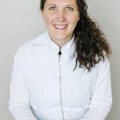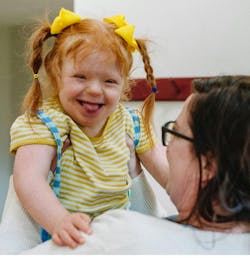How one mom’s advocacy changed a Harvard Dental School’s policy on removal of occlusal calculus in tube-fed patients
The day Candi Kidd, a dental hygienist, met her now-daughter Miley, the little girl was living in a medical foster home run by an 80-year-old woman. When Candi looked into Miley’s face, she felt the same deep knowing she had when she met her three biological children in the hospital. Their hearts recognized each other instantly.
Miley is medically complex and sees 19 specialists. Candi knew her care would be intensive, but she thought: At least I can handle what’s between her nose and chin. I have a bachelor’s in dental hygiene. Yet the truth was, Miley’s oral conditions overwhelmed even her.
Many mornings, when Candi lifted Miley from bed, she’d find blood on her pillow. Her tiny mouth was covered in thick calculus, and her primary teeth were refusing to fall out. There was also a distinct oral odor that every hygienist recognizes as a sign of periodontal disease.
Her family’s priority became giving Miley a fresh start with her oral health. Candi scheduled a dental procedure at their local hospital under anesthesia for a full exam, the removal of eight retained teeth, and comprehensive periodontal therapy.
When Miley woke from sedation, Candi gently checked her mouth, expecting the calculus to be gone. Instead, her heart sank. Thick calculus was still caked onto the occlusal surfaces of her teeth.
Confused and concerned, Candi asked why the dentist hadn’t removed it. The response stunned her: “We leave it as a caries prevention measure because it acts as a natural sealant.”
Her stomach twisted. How did I not know this as a dental professional? How does everyone know this but me? she wondered.
She went home and started digging into the research. What she found was alarming.
Research into aspiration pneumonia
The evidence was clear: G-tube-fed individuals have an extremely low risk for cavities,1 but they face a dangerously high risk for aspiration pneumonia.2 Aspiration pneumonia is not just another infection—it’s one of the leading causes of death for individuals with disabilities and medically complex conditions.3 It occurs when bacteria from the mouth, often trapped in thick calculus, enters the lungs through saliva, reflux, or accidental inhalation.4 For tube-fed individuals, the risk is even greater.5
Aspiration pneumonia can lead to:
- Severe lung infections
- Respiratory distress
- Extended hospital stays
- Intubation and mechanical ventilation
- Sepsis (a life-threatening response to infection)
- Permanent lung damage
- Death6
Despite this, the dentist’s reasoning had focused solely on cavity prevention—a problem that rarely affects children like Miley.
At first, Candi doubted herself. What if removing the calculus somehow increased the risk? But study after study confirmed the opposite. Professional calculus removal does not cause aspiration pneumonia. Leaving it there can.7
Candi began contacting other hospitals to learn whether this practice was common. None reported leaving occlusal calculus in place as a standard caries prevention measure.
A talk with Harvard Dental School
Eventually, she reached a key decision-maker at Harvard Dental School. She came ready for a conversation rooted in science, research, and patient safety. But instead, she was met with resistance.
“No one has ever questioned this before. We’ve never had a problem. We are Harvard, and this is how we’ve always done it.”
But Candi pushed back. “You’ve never had a problem that you know of,” she replied. “Miley is my baby. She is medically complex. Every decision for her is deliberate, thoughtful, and based on evidence. We don’t have the luxury of doing things just because that’s how they’ve always been done.”
The conversation was tense. She could hear the discomfort in their voices—the resistance to being challenged. But to their credit, they agreed to review the research.
A few weeks later, Candi received an email. Harvard’s dental team had reviewed the evidence and made a new policy decision: From now on, they would remove occlusal calculus in tube-fed patients.
She stared at the screen, tears filling her eyes. This wasn’t just a win for Miley. It was a win for every medically complex child—especially those without a voice to advocate for themselves. It is impossible to know how many lives may be saved because Candi refused to accept complacency and demanded better.
That night, as Miley drifted to sleep, Candi held her close. Her daughter’s soft breath was warm against her cheek. She ran her fingers through her hair, kissed her forehead, and whispered into the quiet:
I love you. And I will never, ever stop fighting for you.
Editor’s note: This article first appeared in Clinical Insights newsletter, a publication of the Endeavor Business Media Dental Group. Read more articles and subscribe.
References
- Littleton NW, Carter CH, Kelly RT. Studies of oral health in persons nourished by stomach tube. I. Changes in pH of plaque material after the addition of sucrose. J Am Dent Assoc. 1967;74(1):119-123. doi:10.14219/jada.archive.1967.0028
- Hidas A, Cohen J, Beeri M, Shapira J, Steinberg D, Moskovitz M. Salivary bacteria and oral health status in children with disabilities fed through gastrostomy. Int J Paediatr Dent. 2010;20(3):179-85. doi:10.1111/j.1365-263X.2010.01039.x
- RightCare: Learning disability and aspiration pneumonia scenario. NHS England. June 20, 2023. Updated February 19, 2024. https://www.england.nhs.uk/long-read/rightcare-learning-disability-and-aspiration-pneumonia-scenario/
- Sanivarapu RR, Vaqar S, Gibson J. Aspiration pneumonia. In StatPearls. StatPearls Publishing; 2025. https://www.ncbi.nlm.nih.gov/books/NBK470459/
- Elmahdi A, Eisa M, Omer E. Aspiration pneumonia in enteral feeding: a review on risks and prevention. Nutr Clin Pract. 2023;38(6):1247-1252. doi:10.1002/ncp.11020
- Aspiration pneumonia health & safety alert. Commonwealth of Virginia Department of Behavioral Health and Developmental Services. October 2021. https://dbhds.virginia.gov/wp-content/uploads/2022/04/Aspiration-Pneumonia-HS-Alert-October-2021.pdf
- Jawadi AH, Casamassimo PS, Griffen A, Enrile B, Marcone M. Comparison of oral findings in special needs children with and without gastrostomy. Pediatr Dent. 2004;26(3):283-288.
About the Author

Candi Kidd, MEd, BSDH
Candi Kidd, MEd, BSDH, likes to joke that she’s the only “Candi” that’s actually good for patients’ teeth! Candi is known for her ability to make oral health education approachable and impactful. As a special-needs mom, she has a deep passion for improving oral care within the special-needs community. Her accomplishments include serving as a dental expert on television for ABC’s Good Things Utah and partnering with Harvard Dental School and Boston Children’s Hospital to spearhead innovative dental policy changes. Candi lives on a small farm outside Boston, Massachusetts, with her husband and four children. There, she balances her passion for oral health with her love for family life and the simple joys of farm living.

Shelley Brown, MEd, BSDH, RDH, FADHA
Shelley Brown, MEd, BSDH, RDH, FADHA, is a dental educator, speaker, content creator, and mobile clinician dedicated to advancing accessible and innovative dentistry. As co-owner of HYGIENE edgeUCATORS, she empowers dental educators through professional development. Since 2009, she has taught at the Utah College of Dental Hygiene and founded Homebound Smiles, a mobile dental practice serving underserved patients. She also runs Shelley.Dental, a YouTube and TikTok platform focused on patient education and minimally invasive dentistry. Shelley was a cofounder of Hygiene Edge and was honored with the 2025 Sunstar/RDH Award of Distinction for her passionate advocacy for oral health access. Connect with her at shelley.dental, on Instagram @shelley_the_hygienist, on LinkedIn at Shelley Brown, or at [email protected].

